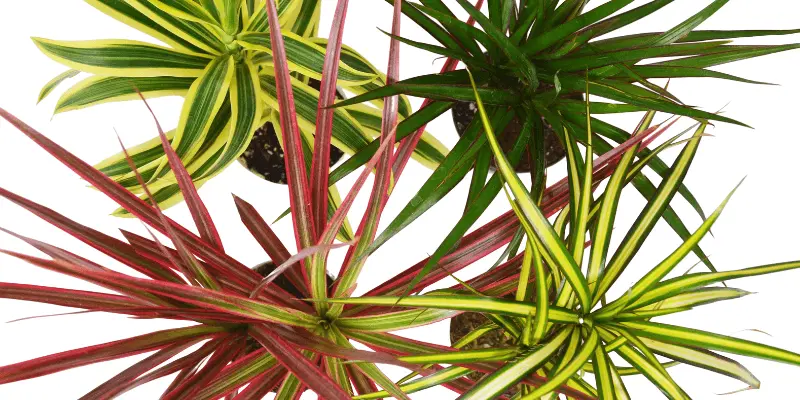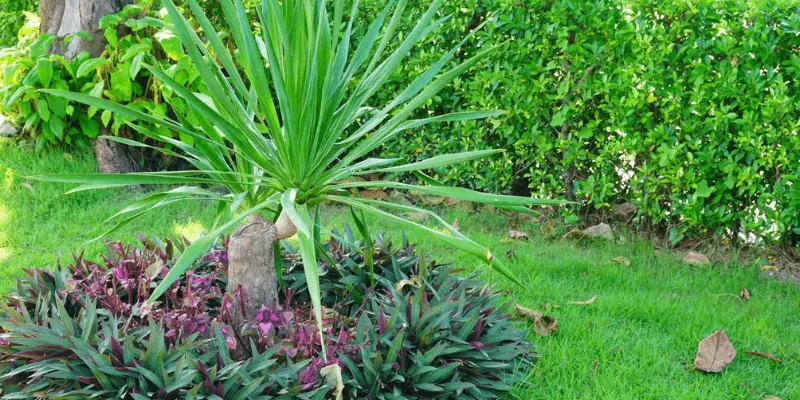Dracaena Care Guide: Types And Growing Tips For Dracaena Indoor

In the world of indoor gardening, dracaena plants are revered for their stunning appearance and ease of care. These hardy houseplants not only add beauty to your living space but also purify the air, making them a great choice for any home.
Dracaena, a genus of striking and versatile indoor plants, has gained great popularity among plant enthusiasts due to its aesthetic appeal and low maintenance requirements. Whether you’re an experienced indoor gardener or a beginner looking to spruce up your living space with lush greenery, it’s important to understand how to care for dracaena. In this comprehensive guide, we’ll cover the art of growing and nurturing Dracaena indoor plants.
Understanding Dracaena
Dracaena is a genus of over 120 species, known for its diverse foliage and growth habits. These plants belong to the Asparagaceae family and are native to Africa, mainly Madagascar. Dracaena species vary widely in appearance, with some displaying vibrant red or pink edging on their leaves, while others exhibit striking patterns or bold stripes. Their adaptability to a variety of lighting conditions and relatively low maintenance requirements make them a favorite among indoor gardeners.
| Common Name | Dracaena; various species have different common names |
| Botanical Name | Dracaena spp. (also Cordyline spp.) |
| Family | Asparagaceae |
| Plant Type | Shrub |
| Mature Size | 2-10 ft. tall, 1-2 ft. wide |
| Sun Exposure | Partial |
| Soil Type | Moist, well-drained |
| Soil pH | Acidic |
| Hardiness Zones | 10–12 (USDA) |
| Native Area | Asia, Africa, Australia |
| Toxicity | Toxic to dogs and cats |
Types of dracaena indoor plants
Dracaena, a diverse and attractive genus of indoor plants, offers an array of choices to add greenery to your living space. With over 120 different species and cultivars, Dracaena plants vary not only in appearance but also in their care requirements.

Dracaena Marginata (Madagascar Dragon Tree)
Dracaena marginata, often called the Madagascar dragon tree, is a popular choice among indoor gardeners due to its striking appearance and relatively easy care. This variety boasts slender, arching leaves with red or pink margins, creating an attractive contrast. What you need to know about Dracaena Marginata care:
Light Requirements: Dracaena Marginata thrives in bright, indirect light but can tolerate low light conditions, making it a versatile choice for a variety of indoor spaces.
Watering: Keep the soil moderately moist and avoid overwatering, as excess moisture can cause root rot. Allow the top inch of soil to dry out between waterings.
Dracaena Fragrans (corn plant)
Known for its distinctive resemblance to corn plants, Dracaena Fragrans is a visually appealing choice for indoor gardening. Its long, arching leaves feature green leaves with yellow or white stripes, adding a touch of elegance to any room. Important tips for caring for Dracaena Fragrans include:
Light Requirements: This variety adapts to moderate to low light conditions, making it a great option for offices or areas with limited natural light.
Watering: Allow the soil to dry out slightly between waterings. Dracaena Fragrans prefers soil that is not constantly wet.
Dracaena reflexa (Song of India)
Dracaena Reflexa, also known as Song of India, is celebrated for its lance-shaped leaves that are adorned with yellow stripes down the center. This variety adds vibrancy and beauty to indoor spaces. To care for Dracaena Reflexa:
Light Requirements: Provide bright, indirect sunlight for best growth. High humidity levels are appreciated, making regular dusting beneficial.
Watering: Keep the soil moderately moist but avoid waterlogged conditions. Ensure good drainage to prevent root rot.
Dracaena Compacta (Dwarf Dracaena)
Dracaena Compacta, often called Dwarf Dracaena, is a compact and manageable indoor plant. Its glossy, dark green leaves give it a glossy appearance, making it a popular choice for small spaces and offices. Here’s how to care for Dracaena Compacta:
Light Requirements: This variety thrives in moderate to low light conditions, making it an excellent choice for areas with minimal natural light.
Watering: Water sparingly and ensure proper drainage to prevent waterlogged soil. Dracaena Compacta prefers slightly dry conditions.
Dracaena Warneckii (Striped Dracaena)
Dracaena Warneckii, also known as Striped Dracaena, is distinguished by its bold white stripes against dark green leaves. This visually appealing variety can thrive in a variety of indoor environments. Dracaena Warneckii care guidelines are:
Light Requirements: Provide bright, indirect light for optimal growth. Dracaena Warneckii can adapt to low light conditions but can grow more slowly.
Watering: Maintain moderate moisture levels by allowing topsoil to dry out before watering again. Avoid waterlogged soil.
These are just a few examples of the variety of Dracaena indoor plants available to enhance your living space. When choosing the right dracaena variety for your home, consider factors such as lighting conditions and care preferences to ensure a successful and visually pleasing indoor garden. With proper care, these plants will thrive and bring a touch of nature’s beauty to your indoor oasis.
How to grow Dracaena indoor

Moderation is key: Water your dracaena sparingly. Allow the top inch (2.5 cm) of soil to dry out between watering’s. Stick your finger into the soil to test the moisture level before watering.
Use well-draining soil: Plant your dracaena in well-draining soil to prevent water from pooling around the roots. Good drainage is essential to prevent root rot.
Consider humidity: Dracaena appreciates high humidity levels. You can maintain humidity by misting the leaves occasionally or placing a humidity tray nearby.
Temperature and environment: Creating the right indoor environment is critical to Dracaena’s well-being:
Temperature Range: Keep your indoor space at a constant temperature between 65-80°F (18-27°C). Avoid exposing your dracaena to drafts or sudden temperature fluctuations, which can stress the plant.
Avoid cold drafts: Dracaena is sensitive to cold drafts. Make sure your plant is away from air conditioning vents, open windows or other sources of cold air.
Fertilization: To keep your Dracaena healthy and thriving, it’s important to provide proper nutrition:
Balanced Fertilizer: Use a balanced, water-soluble fertilizer with equal proportions of nitrogen (N), phosphorus (P), and potassium (K). Fertilize your dracaena every 4-6 weeks during the growing season, which usually spans spring and summer.
Reduce Fertilization in Winter: Reduce the frequency of fertilization during the dormant winter months, when growth slows.
Pruning and care: Regular maintenance is essential to maintain the beauty and life of Dracaena:
Pruning: Cut off brown or yellow leaves with clean, sharp scissors or pruning shears. This not only improves the appearance of the plant but also encourages new growth.
Repotting: Dracaena generally does not require frequent repotting. Repot when the plant outgrows its current container or when you see signs of root crowding.
By following these detailed growing tips for Dracaena indoor plants, you can create a thriving and aesthetically pleasing indoor garden. Remember that each Dracaena variety may have specific care requirements, so it’s important to familiarize yourself with the specific needs of your chosen species or cultivar. With patience and careful care, your Dracaena will reward you with its lush foliage and lasting beauty.
Dracaena Care
we’ll delve into the art of Dracaena care, ensuring that your indoor plants flourish with vitality. Following points involve in the care of plant.

Lighting requirements
Adequate lighting is essential for the health and growth of Dracaena plants. Understanding their light preferences is key to successful maintenance:
Bright, indirect light: Dracaena thrives in bright, indirect sunlight. Place your plants near windows with filtered light to provide ideal light conditions without exposing them to direct sunlight, which can scorch their leaves.
Low light tolerance: Some species of Dracaena, such as Dracaena fragran (corn plant), can tolerate low light conditions, making them suitable for areas with limited natural light. However, they may grow more slowly in such environments.
Avoid direct sunlight: Direct sunlight should be avoided, as it can damage the leaves. Protect your Dracaena from harsh, direct sunlight.
Give water: Proper watering practices are essential for maintaining healthy Dracaena plants
Moderate: Water your dracaena moderately. Allow the top inch (2.5 cm) of soil to dry out between waterings. Use your finger to check the soil moisture level before watering.
Well-drained soil: Plant your dracaena in soil that provides good drainage. Avoid waterlogged conditions, as excessive moisture can cause root rot.
Consider humidity: Dracaena benefits from high humidity levels. You can maintain humidity by misting the leaves occasionally or placing a humidity tray nearby.
Temperature and indoor environment: Creating the right indoor environment is critical to the well-being of your Dracaena plants:
Temperature Range: Maintain a constant internal temperature between 65-80°F (18-27°C). Avoid exposing your plants to drafts or sudden temperature fluctuations, which can stress them.
Avoid cold drafts: Dracaena is sensitive to cold drafts. Make sure your plants are away from air conditioning vents, open windows or other sources of cold air.
Fertilization: To keep your Dracaena plants thriving and vibrant, provide them with proper nutrition:
Balanced Fertilizer: Use a balanced, water-soluble fertilizer with equal parts nitrogen (N), phosphorus (P) and potassium (K). Fertilize your dracaena every 4-6 weeks during the growing season, which usually spans spring and summer.
Reduce Fertilization in Winter: Reduce the frequency of fertilization during the dormant winter months, when growth slows.
Pruning and care: Regular maintenance ensures that your Dracaena plants remain visually appealing and healthy:
Pruning: Cut off brown or yellow leaves with clean, sharp scissors or pruning shears. Pruning not only enhances the appearance of the plant but also promotes new growth.
Repotting: Dracaena generally does not require frequent repotting. Consider repotting when your plant has outgrown its current container or shows signs of root crowding.
Common Pests and Plant Diseases

Dracaena, with its spectacular foliage and adaptability to indoor environments, is typically a hardy houseplant. However, like all plants, it can be susceptible to certain pests and diseases. Being aware of these common problems and knowing how to identify and deal with them is vital to maintaining the health and beauty of your Dracaena plants.
Prevention is often the best strategy for dealing with pests and diseases in Dracaena plants. Inspect your plants regularly for signs of trouble, maintain adequate water and humidity levels, and isolate any infected plants to prevent the spread of problems. Early detection and prompt treatment are essential to keep your Dracaena plants healthy and thriving.
Dracaena Plant Benefits
Dracaena plants, with their spectacular foliage and ease of care, offer many benefits that go beyond their aesthetic appeal. Whether you’re looking to improve your indoor environment or are looking for a low-maintenance houseplant companion, dracaena offers countless benefits. Here are some of the main benefits of having Dracaena plants in your home: Air Purification, Improved Indoor Air Quality, Natural Humidifiers, Stress Reduction, Aesthetic Appeal, Low Maintenance, Versatility, Improved Productivity, & Natural Beauty and Elegance. Dracaena plants offer many benefits beyond their decorative appeal. From purifying the air to promoting wellness and providing low-maintenance beauty, these versatile indoor plants can be a valuable addition to any home. Whether you’re looking for clean air, a touch of nature, or a sense of calm, Dracaena is a great choice for both the novice and seasoned plant enthusiast.




